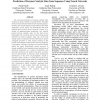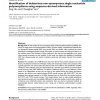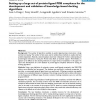69 search results - page 13 / 14 » Prediction of the Number of Residue Contacts in Proteins |
CIBCB
2007
IEEE
13 years 9 months ago
2007
IEEE
The accurate prediction of enzyme catalytic sites remains an open problem in bioinformatics. Recently, several structure-based methods have become popular; however, few robust seq...
BMCBI
2008
13 years 5 months ago
2008
Background: As the number of non-synonymous single nucleotide polymorphisms (nsSNPs), also known as single amino acid polymorphisms (SAPs), increases rapidly, computational method...
JIB
2007
13 years 5 months ago
2007
As protein-protein interactions are one of the basic mechanisms in most cellular processes, it is desirable to understand the molecular details of protein-protein contacts and ult...
BMCBI
2004
13 years 5 months ago
2004
Background: The increasing number of protein sequences and 3D structure obtained from genomic initiatives is leading many of us to focus on proteomics, and to dedicate our experim...
BMCBI
2007
13 years 5 months ago
2007
Background: The number of algorithms available to predict ligand-protein interactions is large and ever-increasing. The number of test cases used to validate these methods is usua...



